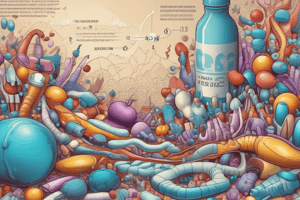Podcast
Questions and Answers
Which of the following physiological responses would be expected following the administration of glucocorticoids?
Which of the following physiological responses would be expected following the administration of glucocorticoids?
- Decreased gastric acid secretion to protect the stomach lining.
- Suppression of gluconeogenesis to reduce blood sugar levels.
- Enhanced bone formation to strengthen the skeletal structure.
- Increased glucose availability in the bloodstream. (correct)
A patient with rheumatoid arthritis is prescribed a glucocorticoid. What is the primary mechanism by which this medication provides therapeutic benefit?
A patient with rheumatoid arthritis is prescribed a glucocorticoid. What is the primary mechanism by which this medication provides therapeutic benefit?
- Suppressing the inflammatory response in the joints. (correct)
- Increasing mineralocorticoid activity to regulate electrolyte balance.
- Enhancing the production of adrenal corticotropic hormone (ACTH).
- Stimulating bone formation to counteract arthritis-related bone loss.
A patient is on long-term glucocorticoid therapy. Which potential adverse effect should be closely monitored?
A patient is on long-term glucocorticoid therapy. Which potential adverse effect should be closely monitored?
- Improved insulin sensitivity.
- Increased bone density.
- Hypoglycemia.
- Sepsis. (correct)
A patient with asthma is prescribed an inhaled corticosteroid (glucocorticoid). What is the rationale for using this medication in asthma management?
A patient with asthma is prescribed an inhaled corticosteroid (glucocorticoid). What is the rationale for using this medication in asthma management?
If a patient has a deficiency in glucocorticoids due to adrenal insufficiency, what would be a potential treatment approach?
If a patient has a deficiency in glucocorticoids due to adrenal insufficiency, what would be a potential treatment approach?
A patient on long-term glucocorticoid therapy is scheduled for surgery. Why might the healthcare provider consider adjusting the glucocorticoid dosage?
A patient on long-term glucocorticoid therapy is scheduled for surgery. Why might the healthcare provider consider adjusting the glucocorticoid dosage?
After an organ transplant, glucocorticoids are often administered. What is the primary reason for this practice?
After an organ transplant, glucocorticoids are often administered. What is the primary reason for this practice?
A patient presents with signs of Cushing's syndrome due to prolonged glucocorticoid use. Which of the following findings would be least likely?
A patient presents with signs of Cushing's syndrome due to prolonged glucocorticoid use. Which of the following findings would be least likely?
A client taking glucocorticoids is advised to avoid NSAIDs. What is the primary reason for this recommendation?
A client taking glucocorticoids is advised to avoid NSAIDs. What is the primary reason for this recommendation?
A client on long-term glucocorticoid therapy reports experiencing significant mood swings and increased irritability. Which serious adverse effect of glucocorticoids might the client be experiencing?
A client on long-term glucocorticoid therapy reports experiencing significant mood swings and increased irritability. Which serious adverse effect of glucocorticoids might the client be experiencing?
Why should glucocorticoids be administered in the morning with food?
Why should glucocorticoids be administered in the morning with food?
A client is prescribed a topical glucocorticoid for eczema. What instruction should the nurse include in the client's teaching?
A client is prescribed a topical glucocorticoid for eczema. What instruction should the nurse include in the client's teaching?
A client with a history of asthma is prescribed an inhaled glucocorticoid via a metered-dose inhaler (MDI). What is the purpose of using a spacer with the MDI?
A client with a history of asthma is prescribed an inhaled glucocorticoid via a metered-dose inhaler (MDI). What is the purpose of using a spacer with the MDI?
A client is prescribed long-term glucocorticoid therapy. Which dietary changes are most important for the nurse to reinforce?
A client is prescribed long-term glucocorticoid therapy. Which dietary changes are most important for the nurse to reinforce?
A client taking glucocorticoids is advised to receive necessary vaccinations, but to avoid live-attenuated vaccines. Which vaccine should the client avoid?
A client taking glucocorticoids is advised to receive necessary vaccinations, but to avoid live-attenuated vaccines. Which vaccine should the client avoid?
A client who has been on long-term glucocorticoid therapy is being tapered off the medication. What is the most critical reason for tapering the dose gradually?
A client who has been on long-term glucocorticoid therapy is being tapered off the medication. What is the most critical reason for tapering the dose gradually?
Flashcards
Glucocorticoids
Glucocorticoids
Hormones that regulate metabolism and immune response.
Glucocorticoids primary use
Glucocorticoids primary use
Inflammation reduction through glucocorticoid use.
Glucocorticoids effect on blood sugar
Glucocorticoids effect on blood sugar
Increased blood sugar and reduced insulin sensitivity.
Glucocorticoids effect on Bone
Glucocorticoids effect on Bone
Signup and view all the flashcards
Glucocorticoids and Infection
Glucocorticoids and Infection
Signup and view all the flashcards
Glucocorticoids fluid retention
Glucocorticoids fluid retention
Signup and view all the flashcards
Common Glucocorticoids indications
Common Glucocorticoids indications
Signup and view all the flashcards
Corticosteroids
Corticosteroids
Signup and view all the flashcards
Gastritis and Ulcers
Gastritis and Ulcers
Signup and view all the flashcards
Cushing Syndrome
Cushing Syndrome
Signup and view all the flashcards
Glucocorticoid Timing
Glucocorticoid Timing
Signup and view all the flashcards
Tapering Glucocorticoids
Tapering Glucocorticoids
Signup and view all the flashcards
Glucocorticoid Diet
Glucocorticoid Diet
Signup and view all the flashcards
Topical Glucocorticoids
Topical Glucocorticoids
Signup and view all the flashcards
Oral Candidiasis
Oral Candidiasis
Signup and view all the flashcards
Preventing Oral Candidiasis
Preventing Oral Candidiasis
Signup and view all the flashcards
Study Notes
- Corticosteroids refer to glucocorticoids, mineralocorticoids, and androgenic sex hormones.
- These are regulated and synthesized by the hypothalamic-pituitary-adrenal axis as needed.
- Stress triggers the hypothalamus to release corticotropin releasing hormone (CRH).
- CRH then activates the anterior pituitary to secrete Adrenal Corticotropic Hormone (ACTH).
- ACTH activates the adrenal glands to secrete glucocorticoid hormone (cortisol).
- High cortisol levels trigger a negative feedback mechanism, shutting down CRH and ACTH production.
- Glucocorticoids are steroid hormones that regulate metabolism and immune response.
Functions of Glucocorticoids
- Suppress inflammation
- Suppress bone formation
- Promote gluconeogenesis, increasing glucose availability
- Increase gastric acid secretion
Use and Indications of Glucocorticoids
- Primarily used for anti-inflammatory properties.
- Common prefixes in drug names are "--sone" or "--lone".
- Examples are dexamethasone, hydrocortisone, budesonide, and fluticasone.
- Chronic use (oral) is for chronic inflammation.
- Used in cases of glucocorticoid deficiency like Addison's Disease.
- Suppress the immune system in organ transplantation to prevent rejection.
- They are also used for autoimmune conditions like Systemic Lupus Erythematosus and Inflammatory Bowel Disease.
- Asthma/COPD (inflamed airways/lungs)
- Cerebral/ spinal cord edema from tumor
- Allergic reactions
- Acute use involves percutaneous administration (e.g., injections) for allergic reactions, sepsis, and status asthmaticus.
Adverse Effects
- Can lead to hyperglycemia and insulin resistance, potentially causing diabetes and hypokalemia.
- Sepsis can occur due to immunity suppression and may mask existing infection.
- All fevers, even low-grade, should be investigated.
- Sodium and fluid retention can cause swelling, leading to weight gain and hypertension.
- Bone and muscle weakness can result in decreased bone formation, potentially causing osteoporosis, muscle weakness, and growth restriction in children.
- Stomach problems like gastritis and ulcers can occur.
- Eyesight changes, such as glaucoma and cataracts are also possible long term effects.
- Weight gain is a common side effect.
Serious Effects
- Mood swings/psychosis (sadness)
- Cushing Syndrome can occur, characterized by a wide round or moon-shaped face, cervical fat deposits, truncal obesity, fragile skin/bruising, acne, and hirsutism due to changes in androgen hormones.
Client Teaching
- Should be taken in the morning with food to mimic the body's natural cortisol secretion and reduce GI effects.
- The dose should be tapered and stopping abruptly can cause acute adrenal crisis, a life-threatening condition.
- Anticipate weight gain and maintain regular exercise.
- Advise dietary changes such as increased calcium and vitamin D, high potassium, and low sodium.
- Report signs of blood glucose elevation, visual changes
- Avoid concurrent use of NSAIDs
- Reduce risk of infection by staying current with vaccinations (except live-attenuated vaccines like nasal spray influenza or MMR) vaccinations.
- Avoid large crowds
Topical Glucocorticoids
- Reduction of inflammation in eczema, psoriasis, contact dermatitis, allergies, and insect bites.
Adverse Effect of Topical Glucocorticoids
- Acne
- Stretch marks
- Skin thinning is possible, avoid using on the face, groin, underarm, or near eyes.
- Avoid occlusive dressing unless prescribed, as it can increase absorption leading to overdose.
Inhaled Glucocorticoids
- Delivered through Metered Dose Inhalers to reach deep into the lungs.
- Spacers hold fine particles of the drugs until inhalation, helpful for those with timing issues.
- After depressing the inhaler, the client should take a big breath and hold it briefly.
- The spacer allows an extra breath if needed to get the full dose.
- Dry powder inhalers are another delivery method.
Adverse Effects of Inhaled Glucocorticoids
- Oral candidiasis is a fungal/yeast infection in the mouth appearing as white patches or sores. Rinsing the mouth after medication can prevent this.
- Hoarseness is another potential side effect.
Studying That Suits You
Use AI to generate personalized quizzes and flashcards to suit your learning preferences.
Related Documents
Description
An overview of corticosteroids, emphasizing glucocorticoids, their synthesis via the hypothalamic-pituitary-adrenal axis, and their functions. It highlights their role in suppressing inflammation, bone formation, and promoting gluconeogenesis. Also covers common uses and indications of Glucocorticoids.




